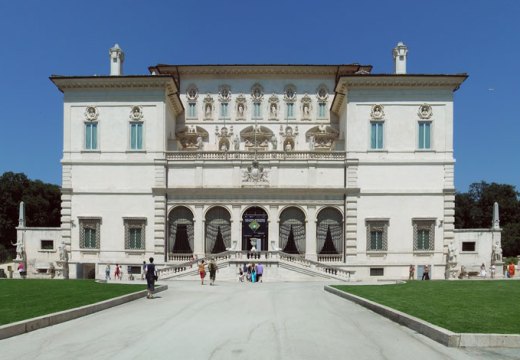A number of plinths stand empty at the Fondazione Prada’s new space in Milan. It is no mistake; the exhibition’s curators want to highlight the absence of Myron’s Discobolus, Polyclitus’s Doryphorus and Praxiteles’s Satyr. These (yet) undiscovered Greek bronzes are known through literary sources and the later copies that fill this exhibition. This mix of Roman marbles and modern plasters does not just inform us about the appearance of the absent originals, but encourages the interrogation of our ideas about originality, authenticity and the copy.

The Discobolus, Exhibition view of ‘Serial Classic’, co-curated by Salvatore Settis and Anna Anguissola, Fondazione Prada Milano (2015). Photo: Attilio Maranzano. Courtesy Fondazione Prada
For an exhibition of copies, it is hearteningly diverse. Variations on the Discobolus, all from the 1st and 2nd centuries AD, range from the Vatican’s near complete marble to a disembodied arm holding a discus from the Casa Buonarroti, and includes two fragments wrongly restored as a dying warrior and Endymion. Marble is dominant but not exclusive – reproduced parts of the Doryphorus from between the 1st century BC and 1st century AD are in marble, bronze and schist, a stone comparable to bronze in its darker and greener varieties. This historic diversity is juxtaposed with colour and metallic reconstructions of the Kassel Apollo from 1991, which challenge the retrospective idea of the achromatic classical with their garishness.

The Kassel Apollo, Exhibition view of ‘Serial Classic’, co-curated by Salvatore Settis and Anna Anguissola, Fondazione Prada Milano (2015). Photo: Attilio Maranzano. Courtesy Fondazione Prada
Other sculpture groups are more cohesive. The six copies of Crouching Venus are, thanks to her compact form, more intact. However, this makes small variations – often clues to the sculpture’s original location – more evident. This variation and multiplication was not a Roman invention, as seen with the Greek clay busts of Persephone from Medma (now Rosarno) made with a mould and then individually decorated by artisans.
The theme of multiplicity continues with the yet-unresolved case of the two Greek Penelopes, one of which was buried in Persepolis when Alexander the Great’s troops destroyed the palace, while the other inspired numerous Roman copies. The reuniting of a group of four Pouring Satyrs from the Castel Gandolfo, since disseminated to Dresden, London and Malibu is a microcosm of the show’s combination of the academically apposite and the visually pleasing.

The Pouring Satyrs, Exhibition view of ‘Serial Classic’, co-curated by Salvatore Settis and Anna Anguissola, Fondazione Prada Milano (2015). Photo: Attilio Maranzano. Courtesy Fondazione Prada
The exhibition’s denouement, the Caryatids, points to its short-circuit between Greek ‘originals’, Roman ‘copies’ and reconstructions made over the last century. The female figures who function as columns on the Acropolis, replicated by the Romans at the Forum of Augustus and Hadrian’s Villa at Tivoli, and now seen on innumerable 19th-century buildings, are included via an early 20th-century plaster and 2015 reproductions in plaster and Nylon.
The status of 19th- and 20th-century plaster casts is defended. Despite the role of objects such as the 1927 Amelung Athlete in archaeological studies, casts are little valued due to their mechanical means of reproduction and lowly material. As Settis is keen to remind us, the Romans produced plaster casts from which to make their marble copies and the Greek bronze ‘originals’ were themselves mechanically reproduced.

The Doryphorus, Exhibition view of ‘Serial Classic’, co-curated by Salvatore Settis and Anna Anguissola, Fondazione Prada Milano (2015). Photo: Attilio Maranzano. Courtesy Fondazione Prada
It is in this observation that co-curators Salvatore Settis and Anna Anguissola are most successful in making the classical relevant to contemporary artistic issues. The show’s sister exhibition at Venice is the equally elegant, and eloquent, ‘Portable Classic’ at Fondazione Prada’s Grand Canal palazzo, focusing on the impact of scaled-down copies of classical sculptures on Renaissance art. But ‘Serial Classic’ finds a much younger sibling at the Biennale in ‘The Revenge of the Commonplace’. Here Rinus Van de Velde’s hand-painted Brillo Boxes, previously presented last year in Beijing at the exhibition ‘Master Mould and Copy Room’, are evidently not mechanically reproduced. The deliberate anachronisms of a handmade Warhol replica and Romans carving marble from plaster casts encourage dialogue between those interested in periods of art millennia apart, about shared issues of materiality, authenticity, craft and value.

Crouching Venus, Exhibition view of ‘Serial Classic’, co-curated by Salvatore Settis and Anna Anguissola, Fondazione Prada Milano (2015). Photo: Attilio Maranzano. Courtesy Fondazione Prada
‘Serial Classic’ is at Fondazione Prada, Milan until 24 August; ‘Portable Classic’ is at Fondazione Prada, Venice until 13 September; ‘The Revenge of the Common Place’ is at Palazzo Nani Mocenigo, the VITRARIA Museum, until 30 June.
Related Articles
Hepworth Wakefield puts plaster casts in pride of place
More than just copies: Brussels’ Plaster Cast Workshop
Unlimited access from just $16 every 3 months
Subscribe to get unlimited and exclusive access to the top art stories, interviews and exhibition reviews.














![Masterpiece [Re]discovery 2022. Photo: Ben Fisher Photography, courtesy of Masterpiece London](http://www.apollo-magazine.com/wp-content/uploads/2022/07/MPL2022_4263.jpg)
It’s time for the government of London to return to its rightful home